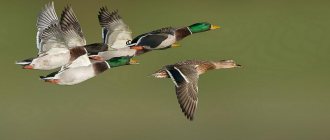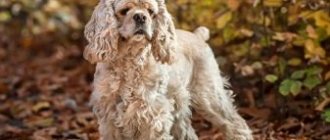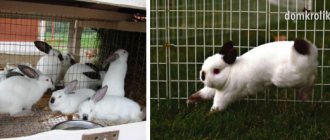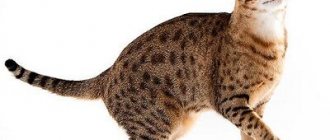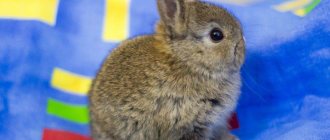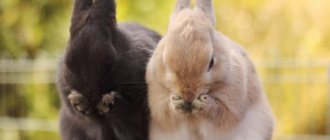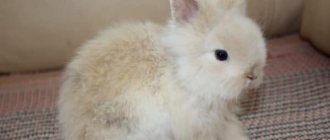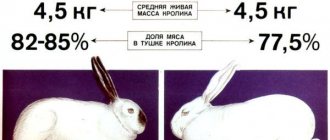The list of pets is not limited to cats, dogs and hamsters. No one is surprised by people with mini pigs on a leash, and many people have dwarf rabbits in their homes - cute animals that evoke universal affection with their appearance. The peculiarity of mini breeds is that they remain miniature even in adulthood, in contrast to decorative rabbits, which are no less attractive in appearance, but grow to industrial sizes.
What is the difference between a dwarf rabbit and a decorative one?
So that, as an adult, the rabbit does not surprise you with its size, you should ask the seller for a certificate
People often wonder: what is the difference between dwarf rabbits and decorative ones. First of all, these are the sizes. When ornamental animals grow up, they can become very large.
But in childhood, all rabbits are small, and it is difficult to independently distinguish a dwarf individual. To avoid mistakes, you need to ask the seller or breeder to present a certificate or show the parents of the future pet.
The smallest rabbit in the world
The Idaho breed is considered the smallest rabbit in the world. This species is also called pygmy and is common in the western United States.
Unfortunately, these little creatures are now on the verge of extinction, and can mainly be found only at the Oregon Zoo.
The weight of these individuals does not exceed half a kilogram, and the body length is 25 cm.
It is almost impossible to buy such animals home: their population is too small today.
Breeds and general description
You will be surprised, but this is exactly what a dwarf ram looks like
When the decision to have a dwarf rabbit has been made, you need to decide on the choice of breed. Such animals are colored and white, and their weight ranges from 700 g to 3 kg.
The following breeds can be found in nurseries and pet stores:
- Dwarf ram;
- Dwarf rex;
- Foxy dwarf rabbit;
- Angora dwarf rabbit;
- Japanese dwarf rabbit;
- Dwarf hare;
- Dwarf rabbit Hermelin;
- Dutch dwarf rabbit.
Angora rabbits are particularly fluffy
Both the appearance and character of the animals depend on the purity of the breed. Some long-eared ones resemble a ball and are very peaceful, while others have rather short fur and a more aggressive character. So, first of all, the animal must evoke sympathy.
A little history of the formation of a line of rabbits with the dwarfism gene
In the second half of the 19th century, breeders began to actively use small silver rabbits for breeding, which have a special gene that ensures small size offspring. Already in 1870, the first dwarf breed was registered in England: the Polish white downy mini rabbit (Britain Petit). In 1920, German breeders introduced the world to a completely new breed - the curly-furred Hermelin. In 1930, colored dwarfs were bred in Holland, and the breed standard was approved in 1940. Dwarf lop-eared rabbits appeared at exhibitions in 1952, and the breed was registered in 1964. The newest among all is the lion-headed dwarf, bred at the beginning of this century. The authorship of this breed of dwarf rabbits is disputed by the Belgians and Americans.
The “best” mini-rabbits – interesting facts
Before describing the breeds, we would like to present to your attention some interesting facts about these funny animals.
- The smallest dwarf rabbit from the USA, registered in the Guinness Book of Records, weighed only 400 g. Although a female weighing 297 g now lives in Chelyabinsk and her owners have applied for the record.
- The rabbit has the longest ears - 79.06 cm.
- The longest life a domestic rabbit has lived was 19 years and 2 months.
On average, dwarf breeds live 7-9 years, and this depends only on the quality of care for the animal, and not on what species it belongs to.
Pros and cons of content
Dwarf rabbits are affectionate and clean, but very susceptible to disease
There are advantages and disadvantages to owning these small, cute animals. Let's start with the pros:
- Cleanliness. Dwarf long-eared cats quickly become accustomed to the litter box, and there is very little litter from them in the apartment.
- These are affectionate, kind pets that immediately become attached to their owners. When they are happy, they click their teeth funny and make pleasant sounds.
- Rabbits are unpretentious in care and nutrition, and their maintenance is quite inexpensive.
The main disadvantage of animals is their pain. They can fall ill not only from infection, but also from sadness. Frequent visits to the veterinarian can take a lot of effort and time. Another disadvantage is the problem of constantly gnawing on something. Buying toys will help solve the problem: the rest of the things in the house will remain intact.
It is also worth considering that each rabbit, despite its small stature, is a personality. They are very touchy and remember bad treatment for a long time.
Features of the view
Buyers often confuse the concepts of “dwarf” and “decorative”. These words cannot be called synonyms at all. Any rabbit that is kept as a pet is considered decorative.
Dwarfs are small fluffy creatures. Such animals comply with the breed standard and have strictly acceptable colors.
Care and maintenance at home
Keeping long-eared pets is not particularly difficult. It is important to choose a healthy animal and prepare a suitable room for it. It should be well ventilated, but without drafts. Heat is also contraindicated for rabbits; they cannot be placed near a radiator.
It is better to buy a cage with galvanized metal rods. Two males will not get along in it, but females or rabbits of different sexes can be placed together. Of course, the size of such a house should be larger.
Many breeders are afraid of unpleasant odors. If you properly care for animals, they will not exist. At the bottom of the cage, it is necessary to pour bedding from pieces of newspapers, sawdust or straw in time. These materials absorb odors well and can be quickly removed.
Long-eared dogs with thick hair need to be brushed regularly. In addition, approximately once every 3 weeks your pet needs to have its claws trimmed.
What to feed a dwarf rabbit
Dwarf rabbits can eat up to 30 times a day
Dwarf rabbits are big eaters: they eat up to 30 times per day. The owners must provide them with adequate nutrition and not restrict food, otherwise they can harm the digestive system. The food that the animal eats is quickly digested and reaches the intestines only after the next meal.
A pet's diet should be varied. It is better if it is based on ready-made balanced food from pet stores. You can also give hay. If the eared dog refuses to eat it, the hay is slightly moistened with water and salt.
The menu must be supplemented with grass, including meadow grass, as well as bone meal and chalk - a long-eared animal cannot do without minerals. It is useful to give oats or wheat soaked in water, fresh fruits and vegetables.
Important: You can give cabbage, which rabbits love, but red cabbage is contraindicated for them.
Sometimes rabbits eat the waste left in the cage. There is no need to be afraid of this: they are harmless to long-eared animals.
Hygiene and bathing
You should only bathe babies if they are very dirty.
Since dwarf rabbits are very clean, there is no need for regular bathing. But if the baby gets very dirty at home or on a walk, it is better not to let him clean himself, but still give him a bath. The rest of the time, you should not expose your baby to stress. He will take care of his own skin, which is also replaced with a new one every six months.
Diseases and treatment
Vaccines and vaccinations are necessary for dwarf rabbits. These gentle creatures, even in comfortable room conditions, can catch a disease such as a cold or conjunctivitis. Both hypothermia and heat stroke are equally dangerous for them. Timely vaccinations will protect rabbits from infections and dangerous diseases such as rabies.
Therefore, the condition of pets must be constantly monitored. The following symptoms may indicate the disease:
- Vomiting, nausea, bloating.
- Loose stools or constipation.
- Belching, rumbling in the stomach, bad breath.
- Fatigue, lethargy, drowsiness.
Even if there are one or two symptoms, the baby should be shown to the veterinarian: delay can be disastrous for him.
Vaccination
The smallest rabbits are protected from diseases by maternal immunity. When they switch to adult food, the body weakens. Vaccinations can begin as early as the sixth week. Animals are vaccinated against rabies, salmonellosis, listeriosis and some other diseases.
Before vaccination, you need to prepare: take care of the prevention of helminthic infestation, monitor the pet’s health, and stop bathing it a week before.
Selecting a cage and accessories
Take care in advance of entertainment for the rabbit in the cage
The dwarf rabbit is a delicate and fragile breed, which must be taken into account when choosing a cage. It is desirable that each individual has its own house. Its size must be 4–5 times the size of an adult rabbit so that the animal can move. It is advisable that its rods be made of unpainted iron: when the baby gnaws on them, his health will not suffer . It is better to choose a plastic pallet.
It is worth taking care in advance about purchasing accessories: tray, feeder, drinking bowl, toys. You also need to buy a manger into which hay will be poured. This is necessary because it quickly deteriorates on the floor.
Rules for choosing a good individual
In order to choose a good and ideally healthy individual rabbit, you need to pay attention to both its external characteristics and characteristic behavioral features
When choosing a baby rabbit, you need to pay attention to the characteristic features of the breed
It is important to remember the following signs that indicate full compliance of an individual with the norms of its breed:
- dense and muscular build;
- weight from 0.8 to 1.5 kg (ideally 1.3 kg);
- thick, dense wool from 40 to 70 millimeters long;
- broad shoulders and chest;
- shortened front legs;
- rounded shape of the rear part with a tight-fitting, vertically directed tail of a small size;
- a large head, which when viewed in profile looks round, and when viewed from the front - short and wide (for females the ideal value at eye level is 50 mm, and for males - 55 mm);
- ears with rounding at the very tips (their length can be from 55 to 70 millimeters;
- expressive and brilliant eyes of large size and slightly convex shape.
The fox rabbit is easily confused with the Angora rabbit
In addition, you should be aware of the signs that are unacceptable for a dwarf fox rabbit:
- the body is elongated, elongated, having a loose structure;
- a noticeably narrowed chest in combination with a large and massive dewlap;
- elongated shoulders, the proportions of which are not in harmony with other parts of the body;
- front and rear legs that are too long or crooked;
- a narrowed or sagging lower part of the body with a sagging or insufficiently tight-fitting tail;
- twisted claws;
- elongated or narrowed head shape;
- pronounced elongated neck;
- widely spaced ears, having an elongated shape without curves;
- small eyes lacking a healthy shine;
- short or uneven coat length;
- sloppy fur - matted or dirty;
- excess body weight;
- abnormal exhaustion;
- malocclusion.
When examining a dwarf fox rabbit, you need to pay attention to its fur - in a healthy individual it is shiny, dense and thick, without the slightest bald spots or combed damage. To assess the condition of the skin, you should stroke the animal several times against the growth of the fur.
The eyes should be absolutely clean and shiny. The presence of redness and discharge may indicate conjunctivitis.
It is important to inspect the animal
The next important point is the condition of the ears. There should be no discharge, redness, inflammation or scabs in the inner ear. Discharge from the nasal passages is also unacceptable.
When completing the examination, you should pay attention to the condition of the fur surrounding the anus - the presence of stuck together lumps, contamination with feces, as well as an unpleasant odor indicate a pathology of the gastrointestinal tract or the feeding and keeping of the animal in unfavorable conditions
When choosing a pet, it is important to pay attention to characteristic behavioral features
Fox rabbits have a playful and friendly disposition, so you should be wary if you detect opposite manifestations of character. Under no circumstances should you buy a baby rabbit if it has no interest in the world around you and no appetite, and also if it does not move around the cage, but constantly tries to hide in the house, frightened of people and any sounds. You should also avoid buying an animal whose behavior is characterized by increased excitability and aggressiveness.
Breeding dwarf rabbits
When breeding rabbits, the key is moderation.
A feature of decorative rabbits is the possibility of early mating. They reach sexual maturity in 6–9 months. At this time, the animals are ready to reproduce. At one time, a female rabbit brings on average 5–7 babies. Breeding rabbits too often is not recommended, as this may affect the quality of the offspring.
How to determine the sex of an animal
Rabbits aged one to two months are practically indistinguishable from each other. The sex of animals can only be determined from documents. The genitals will help determine it externally. The animal must be placed with its belly up on its hind legs. After this, the tail is raised and the genital organ is gently squeezed. The male will have a penis, while the female will have a pink triangle.
Mating and pregnancy
Be prepared that a female rabbit ready for mating will dramatically change her behavior
It is best to breed a dwarf rabbit under the age of one year . When she is ready to breed, her character changes dramatically. The female becomes restless and irritable. At this time, it’s time to place her in the male’s cage, where she will become more docile. Mating occurs almost immediately. Then the animals need to be left alone for a while, and then seated. A day after this, control mating occurs.
Pregnancy in females lasts on average 31 days. If the litter is small and the offspring are large, it may last longer. When there are many rabbits, their mother will give birth faster.
During the first two weeks, the female's diet does not need to be changed. Starting from the third week, the dose should be increased slightly. The menu of the expectant mother should include fruits and vegetables, especially cucumbers: they are believed to enhance lactation. But you still shouldn’t overfeed your rabbit.
How to care for newborn dwarf rabbits
Rabbits are born deaf, blind and require special care. Their mother will look after them, and the owners must provide her with conditions and additional food. It is necessary to prepare a warm place for the offspring in advance: if the rabbits are placed on the floor, they will die.
There is no point in disturbing the rabbit again: she may get scared and harm the newborns. But you will have to make sure that she is always full and does not eat the babies. There is no need to worry that the female spends little time with the children. Unlike dogs and cats, rabbits do not sit with their offspring all the time, but only come to feed them.
Feeding
It is important to feed your dwarf rabbit properly, otherwise it will get sick and need treatment from a veterinarian. The animal's main food is hay. You can prepare it yourself in the summer or buy it at a pet store. The hay chosen is fresh, aromatic, without signs of rotting or mold. If the animal does not want to eat dry grass, it is slightly moistened with salted water or sprinkled with flour.
Dwarf rabbits also eat other foods:
- fresh grass;
- grain (barley, oats, wheat);
- corn cobs;
- boiled potatoes;
- raw or boiled carrots, turnips;
- sugar or fodder beets;
- cabbage;
- apples;
- twig food;
- chalk, special salt stone or meat and bone meal.
Pet stores sell special granulated food that contains the entire list of essential vitamins and minerals. They are given in the evening, 2-3 spoons per individual. Fresh greens and vegetables should not be given in large quantities. It is better to pamper your pet with such food 3-4 times a week. Large amounts of cabbage make animals swell. Animals should not be given sweets, dried fruits, sugar beets, it is advisable not to feed cauliflower, otherwise intestinal diseases will have to be treated.
The animals' diet should contain a large amount of vegetables (cucumbers, radishes, carrots), dried fruits (bananas, raisins, dried apricots), green leaves and fresh hay
The animal eats 6-8 times a day. He has a small stomach and a fast metabolism. Access to food must be constant. Hay should be in the manger around the clock. Wet mash must be removed promptly to prevent it from spoiling. It is good to train your pet to eat at certain hours. Requires 24/7 access to water. It is better to buy an automatic waterer so that the dwarf animal does not overturn the bowl.
Training and playing with your pet
Decorative rabbits just love to play
Dwarf rabbit breeds love to play and can learn some interesting tricks. They perceive training not as coercion, but as an opportunity to have fun. To achieve success, you need to eliminate negativity and aggression from the educational process. The best assistants in training will be praise and treating your pet with treats.
You should not start training your baby immediately after purchase. We need to give him a couple of months to adapt, after which he can begin training.
Distinctive features of dwarf breeds
Among rabbit breeders, there are clear criteria for which mini rabbits belong to dwarf breeds. And the point is only in the small size of the representatives of the breed, but in whether the so-called dwarfism gene is present in the DNA of the animals. Today, only 15 such breeds are officially registered, although there are much more small domestic breeds (not counting mestizos, which are also very popular). In total, there are officially 83 breeds of rabbits in the world, although there are more than 200 bred by amateur breeders (almost 70 of them are in Russia).
Already within these 15 breeds, a large number of subspecies have been bred, which differ in the following parameters:
- color (more than 60 shades, two- and three-color);
- length and shape of the coat (with short, medium and long hair, downy angora, velvet, curly);
- exterior and body proportions;
- the size and shape of the ears (from 6 to 20 cm, erect and drooping - fold);
- weight (mini dwarfs - up to 1.7 kg, medium dwarfs - 1.7-3.0 kg).
How to toilet train an animal
Accustoming a baby rabbit to a litter tray requires a lot of patience from the owner.
The little rabbit is gradually getting used to the toilet, but you will have to be a little patient. It is advisable to remember in which corner the breeder had the tray and place it there at home. It is worth asking the breeder for some used litter and mixing it with the old one. The pet will quickly find its native smell.
If the baby doesn't get into the tray, there's no need to swear. As soon as it becomes noticeable that your pet wants to go to the toilet, you must immediately put him in the litter tray. After a job done successfully, the animal should be praised. If you patiently train your pet to use the toilet day after day, the result will be achieved.
Where is the best place to buy a dwarf rabbit?
If you have already chosen a breed and have made a firm decision to have such a friend, there are two obvious options for purchasing a pet: from a breeder and from a pet store. In both cases, there are a few basic rules that can protect you from future disappointments. The little rabbit must be healthy, friendly, and have good heredity.
In particular, a healthy pet should be active and have a clean, shiny coat. For example, pus in the corners of the eyes may indicate conjunctivitis or other infections, black spots in the ears indicate the presence of mites, and traces of liquid feces on the fur around the anus indicate digestive problems. also important to pay attention to the following factors:
- Age. Experienced breeders advise not to take a baby rabbit younger than one and a half months.
- Availability of vaccinations. Dwarf rabbits are quite fragile creatures. There are several diseases characteristic of these breeds, which will be discussed below.
- Pedigree. The guaranteed absence of hereditary diseases will protect you from many possible problems.
What to name a dwarf rabbit
Choosing a name for these affectionate creatures is not an easy task, because you want your pet to have the most beautiful one. At home, rabbits are called completely differently than on farms.
The name has a certain influence on the character of the pet. A rabbit whose nickname sounds soft has a more docile character than an animal with a harsh name. When choosing, you can take into account body type, color, and other appearance features.
For boys, the names Coal, Ryzhik, and Donut may be suitable. Popular rabbit names are Yasha, Fomka, Stepan. Female rabbits readily respond to the nicknames Bunny, Smokey, Pushinka. Girls with a proud, unapproachable character are given names such as Eva, Gerda, Magnolia.
To quickly accustom your baby to his name, you need to call him as often as possible . If the name is sonorous and short, there will be no problems.
Hygiene and bathing
Rabbits are very clean animals. In nature, they do not need bathing. You can bathe them at home, for example, if their fur is heavily soiled, but not more than once a month. Please note that the pet will probably not be happy with your initiative and will resist. So prepare in advance a bowl of warm water, a special shampoo for rabbits that does not contain SLS (sodium laureth sulfate) or baby soap without fragrances and dyes and a towel, make sure that there are no drafts.
You need to put the rabbit in a basin, carefully soap it and make sure that water does not get into the ears. The animal will have to be held tightly, so you may need an assistant. If possible, it is worth doing with partial washing (paws or butt). This can be done under the tap. After bathing, the rabbit must be dried, wrapped in a towel and not released until it is sufficiently dry. It makes sense to dry long-haired ones with a hairdryer. Do this in the most gentle mode from a distance of at least 40 cm. The fur can be combed with a special brush. Dwarf rabbits also have mandatory regular procedures:
- Trimming claws and incisors. This should be done once every few months as it grows. In nature, rabbits wear down their growing claws naturally. This does not happen at home. As a result, when leaning on the paws, the weight is distributed incorrectly. This can cause finger deformities, calluses, and wounds. The same situation applies to teeth.
- Grooming. Long-haired breeds need brushing every 3-5 days, while others need brushing once every 1.5-2 weeks.
Common diseases
Decorative dwarf rabbits are fragile and delicate creatures, susceptible to stress and a large number of diseases. However, with proper care and timely contact with a veterinarian, almost any ailment can be treated.
Owners need to be careful and alert if:
- the animal hides, hides in a corner and other places unusual for it;
- the coat looks disheveled and dull and begins to shed;
- appetite worsens;
- there is diarrhea or constipation;
- discharge appears from the eyes or nose.
At the first alarming symptoms, it is better not to self-treat, but to immediately show your pet to a veterinarian
Stomach upset
The most vulnerable part of a rabbit’s body is the stomach. Therefore, any disturbances in the animal’s diet can lead to digestive disorders, primarily diarrhea.
Stomach upset is most often caused by:
- eating moldy bread or dry food;
- entering the diet of food affected by pests, for example, weevils;
- sudden change in diet;
- eating excess amounts of vegetables and fruits;
- viral infections;
- pathologies of the digestive system;
- unsanitary conditions in the cage.
As first aid for diarrhea, you can do the following:
- Give the animal a chamomile solution prepared according to the instructions. Dilute the resulting product at the rate of 0.5 tbsp. l. decoction for 1 tbsp. l. water and give three times a day for a week. If the rabbit refuses to drink on its own, you can forcefully pour the product into the mouth using a syringe without a needle.
- Clean and disinfect the cage well. Lay down new bedding.
- Remove all food, vegetables and fruits from the diet, feed only hay and give water.
If the diarrhea does not go away within one or two days, you should immediately consult a veterinarian.
Paralysis
Paralysis often affects the hind limbs and lower spine. The rabbit becomes inactive and lies on its side. This condition leads to constipation and poses a high risk to the life of the animal.
It is known that the disease is easier to prevent than to treat. For the purpose of prevention, it is necessary to ensure that the rabbit does not jump from a height (sofa, table and other furniture), and also does not slip on a smooth surface. In addition to traumatic causes, paralysis can be caused by a lack of vitamins and microelements, as well as infectious diseases. At the first symptoms of the disease, you should consult a specialist.
Rhinitis
As mentioned above, rabbits are very sensitive to drafts and do not tolerate unfavorable environmental conditions. Due to decreased immunity, bacteria develop in animals' bodies, causing runny noses and sneezing. Long-term illness leads to profuse discharge from the eyes and nose, weight loss, and loss of shine in the coat.
From the following video you can learn how and with what to treat a runny nose in rabbits:
Diseases and treatment
Unfortunately, decorative rabbits are susceptible to many diseases. They can be divided into colds, infections, parasitic lesions and diseases associated with poor nutrition and care, and injuries. If you are attentive to your pet, you will easily notice the symptoms: coughing, sneezing, watery eyes, shortness of breath, fever, diarrhea or constipation, a sudden change in behavior for no apparent external reason (possibly due to rabies), swelling of the limb, lameness, etc. Find out what diseases are more often observed in rabbits in your region and require preventive vaccinations at a veterinary clinic.
Be sure to deworm before vaccination
Vaccination
Rabbits are vaccinated at the age of one and a half months. After being separated from their mother for a month, they retain antibodies obtained from milk. It is advisable to have time to vaccinate against diseases during this period. Revaccination is carried out after six months.
Important: Before vaccinations, be sure to deworm. Helminths weaken the immune system, and vaccination can only be carried out in healthy animals.
Rabbits generally require vaccinations against three diseases:
- VVHD (Rabbit Viral Hemorrhagic Disease)
- Myxomatosis
- Rabies (Required when traveling abroad, participating in exhibitions and other official events)
Lop-eared rabbit "ram"
Little rabbits. Dwarf domestic rabbit breeds. Lop-eared rabbit "ram"
It is not for nothing that it is one of the most popular breeds among pets. Compared to colored dwarfs, this breed is slightly larger. An adult can weigh up to 3 kilograms on average. Outwardly, these pets resemble small toys. The drooping ears give the rabbits a rather charming appearance. But this is not all the animal advantages of this breed; in addition to their cute appearance, rabbits are very calm, soft, non-aggressive and friendly creatures.
Even during puberty, a lop-eared rabbit can sit calmly in the arms of its owner, allows itself to be stroked and does not show any signs of aggression. Some attribute his calmness to his drooping ears, which undoubtedly impair his hearing. By giving this decorative rabbit to a child, you won’t be afraid of tears from the animal’s bites or blows.
These rabbits are characterized by a small round body, a wide chest, a virtual absence of a neck, strong legs, well-developed cheeks and muzzle, a large head, and a slightly convex area between the eyes. Don't be afraid if baby rabbits are born with erect ears; after just a few weeks they will droop. But when purchasing an animal, to be completely sure, ask the seller for the documents available for it.
